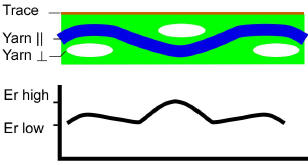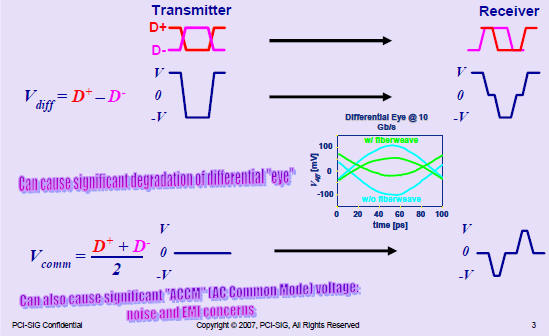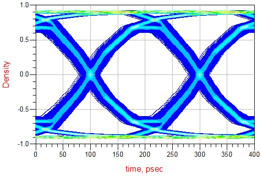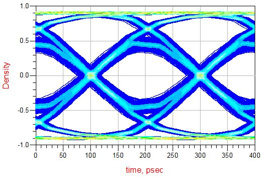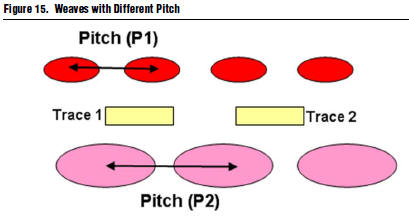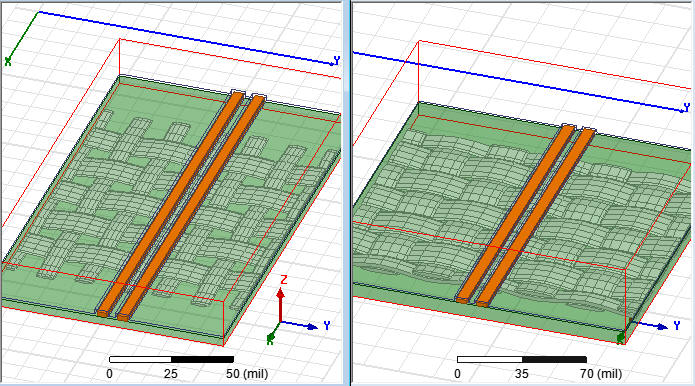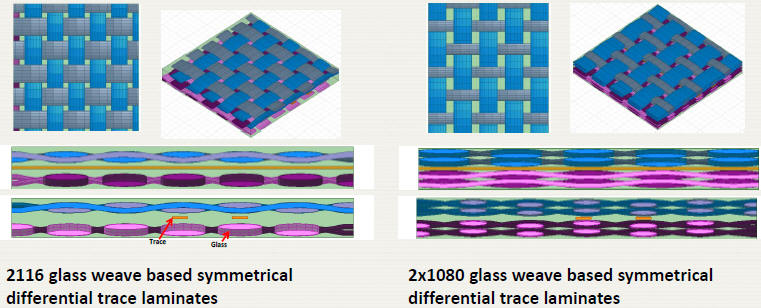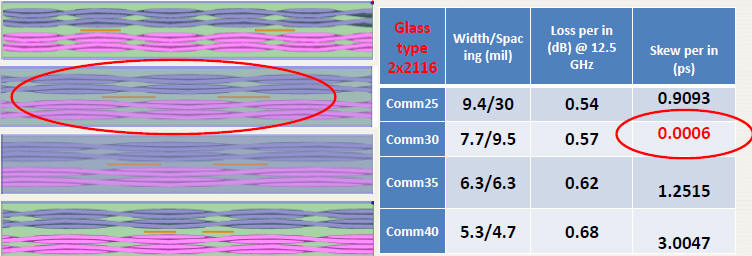線上影音
Home > ANSYS HFSS 教學 > PCB Glass-Fiber Weave Effect
本文始於2014年,並於2020更新。介紹FR4(dielectric layer)的玻璃纖維薄板編織,對高速SI設計的影響,並以HFSS R15實作範例。對於數Gigabit per second以上的高速差動訊號(differential signals),其走線應避免與玻璃纖維編織方向呈0或90o夾角的長距離走線,以降低weaver effect所造成的影響.
This article is intended to introduce all about fiberglass weaver effect, and shows how to simulate it by 3D EM solver (HFSS). Glass type does influence jitter/skew, impedance and common mode conversion.
![]() 常見的說法是glass-fiber (or fiberglass) weave effect,
常見的說法是glass-fiber (or fiberglass) weave effect,而不說glassfiber braid.
-- 新增3 於2020.02
-
問題與討論
![]()
1.1 What reason is weave effect caused by
傳統上PCB的介電層是以玻璃纖維編織,再以環氧樹酯包覆而成。
宏觀上一般以固定的(constant)相對介電係數來表示其特性,比方e=4.4@1GHz,但對於數GHz的高速差動訊號來說,如果走線是沿著玻璃纖維編織方向呈0或90o,這時差動對個別正負訊號的特性阻抗會因為電場流動的路徑上,在微觀所感受到介質結構(特性)不同而不同。
如下圖所示,以上方側的差動對訊號線為例說明:藍色線下方區域都有玻璃纖維編織,而紅色線下方則除了玻璃纖維外,還有環氧樹酯。也就是藍色線受玻璃纖維的介電係數影響為主,紅色線還受環氧樹酯的介電係數影響,兩者的介電係數 完全不同,這會造成差動對訊號線 彼此間的特性阻抗與傳遞時間延遲不 匹配,進而影響到眼圖。[1][2]
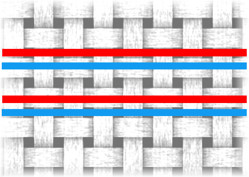
Glass is typically much higher than the quoted bulk figure, ~6 and resin is typically much lower, ~3. A differential pair that uses a trace pitch of around half the weave pitch could quite feasibly see a much lower dielectric constant on one conductor than the other.[1]
1.2 How serious does weave effect affect
雖然weave effect只對於非常高速與很長的差動訊號有影響,但實際情況是,weave effect會多少吃掉一些design budget,降低design margin。[1]
Eye Diagrams: Dielectric constant =4.5 versus dielectric constant of 4.2 (P) & 4.8 (N)
Trace length: 300mm, Data rate: 5Gbps, 100,000 bits including jitter.
1.3 What is the solution for weave effect
有幾種不同的方法可以消除weaver effect,但不論是哪一種方法,都會增加生產成本或設計難度
1.3.1 旋轉整個設計,讓走線方向與板材的編織方向有夾角。
比較貴,因為會有蠻多的PCB板區域被裁掉,但這種作法最簡單
1.3.2 使用特殊的均勻性材質(homogenous materials)
超貴,量產不適合
1.3.3 使用非標準製程的glass fiber,讓玻璃纖維與環氧樹酯的介電係數接近
比較貴
1.3.4 調整差動訊號對的走線寬、走線距離,以避開weave effect
一般差動特性阻抗要求85~100 ohm,如果線寬與線距設計較寬,實務上很難有夠厚的介電層可以匹配
1.3.5 避免使用 '104', '106', '1065' and '1080'這些種類的glass cloths. 使用編織密度較高的dense weave styles, e.g. from '2112' onwards, or composite materials such as Nelco 4000-13SI, Rogers 4250B.
1.3.6 在設計階段儘可能讓高速差動對訊號的走線方向,與glass weave方向有夾角
Zig-Zag Routing for high-speed differential pair
1.3.7 For strip line traces, use two different weaves with different pitches for top and bottom substrates to average out the effect
1.3.8 Offset traces by the intra-pair spacing forcing each trace onto the path that its neighbor was on irrespective of the glass pitch
最後這三招都是Altera想出來的[3],不得不佩服
1.3.9 直接讓PCB基板旋轉一個角度裁切後使用[14]p.112~114 成本比較高就是
2014 DesignCon, Molex Inc.與Insieme Networks Inc.共同發表了一篇用HFSS做的超棒的weave effect模擬報告[6],完整又超水準的演出。
同樣的fiber pitch下,線寬越小的diff. pair設計,對weaver effect越敏感。這是因為越小線寬的結構,其擺放於fiber不同位置所感受到的不均勻性越明顯。
-
Fast 3D Weave Effect Simulation with HFSS [15]

2020 DesignCon, Sony LSI Design Inc.的Kenji Nonaka以HFSS開發了一個快速3D模擬玻纖編織效應的手法。
做法就是以高/低介電材質做適當地週期性分布,來模擬玻璃纖維編織效應對高速訊號的影響。
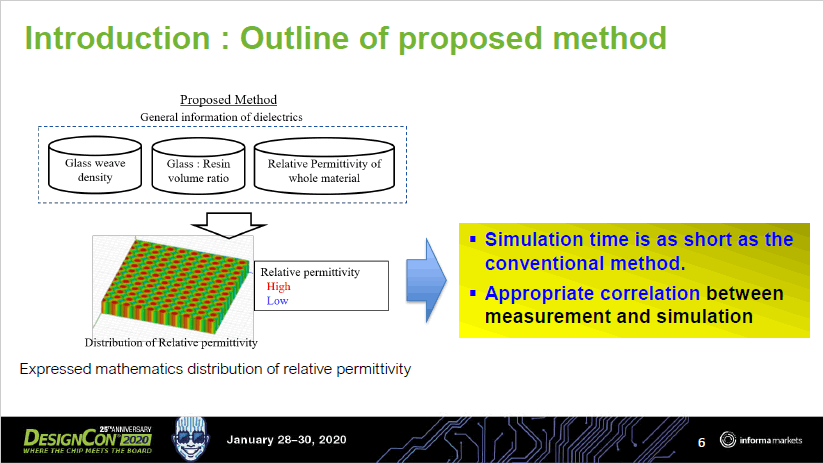
論文中有說明如何計算最大介電係數與最小介電系數。
這篇做得非常非常好,有完整的模擬與量測比對。
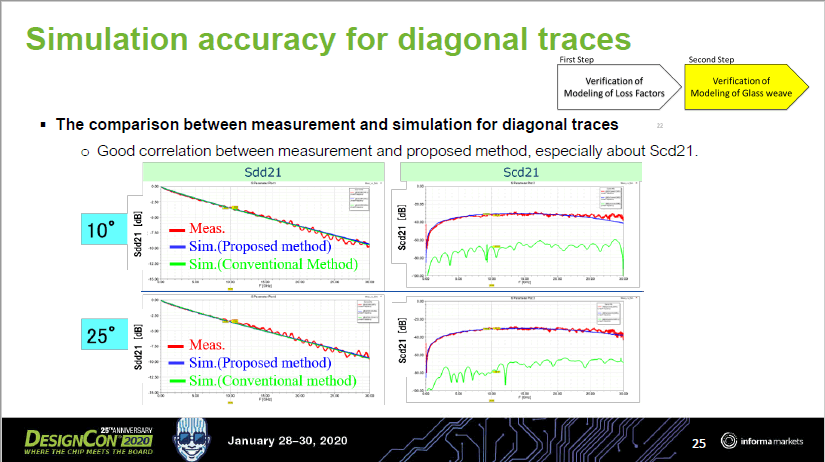
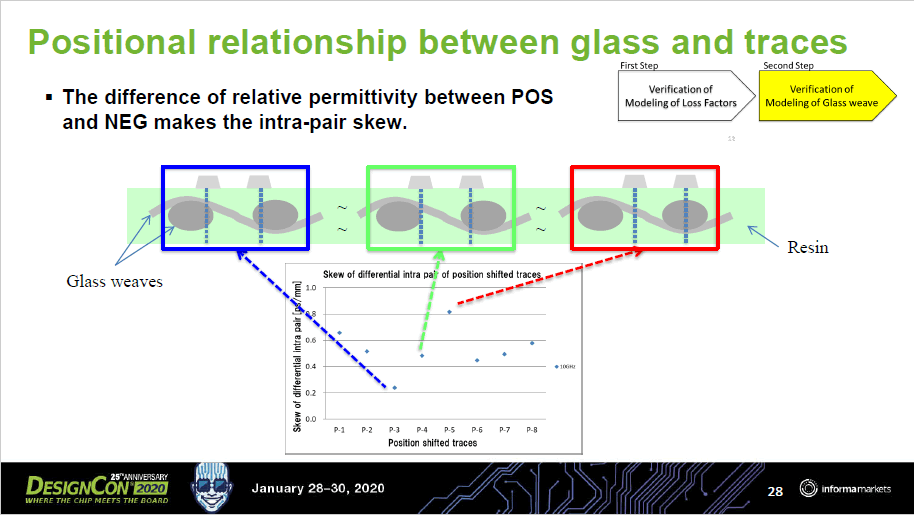
[1] Signal Integrity Analysis \ Fiberglass Weave Effect (推薦)
[2] Jeff Loyer, "PCB Dielectric Material Selection and Fiber Weave Effect", Intel 2007 (推薦)
[3] "PCB Dielectric Material Selection and Fiber Weave Effect on High-Speed Channel Routing", 2011, Altera AN528 (推薦)
[4] "The Impact of PCB Laminate Weave Paper", DesignCon 2005
[5] P. Pathmanathan (Intel), P. G. Huray, "Analytic Solutions for Periodically Loaded Transmission Line Modeling", DesignCon 2013.
[6] P. Amleshi, C. Gao, "Intra-pair Unaccounted Skew -- Effects and Suppression", DesignCon 2014 using HFSS. (推薦)
[7] FUJITSU, "Mitigation of Fiber-Weave Effects by Broadside Coupled Differential Striplines", DesignCon 2015.
[8] Materials for Advanced Packing, p.280
[9] Opening Eyes on Fiber Weave and CAF
[10] On The Problem of Jitter and Skew in Gigabit and Faster Signals Caused by Laminate Weaves, 2007
[11] Woven Glass Reinforcement Patterns
[12] Practical Fiber Weave Effect Modeling, LAMSIM Enterprises Inc., 2011
[13] Understanding Glass Fabric -- Isola
[14] Speeding Edge, "Getting to 32 Gb/S, a tutorial on very high speed differential signaling", DesignCon2018.
[15] Kenji Nonaka, "A Practical Method for3D-Modeling of Glass Weave", DesignCon2020. (推薦)
